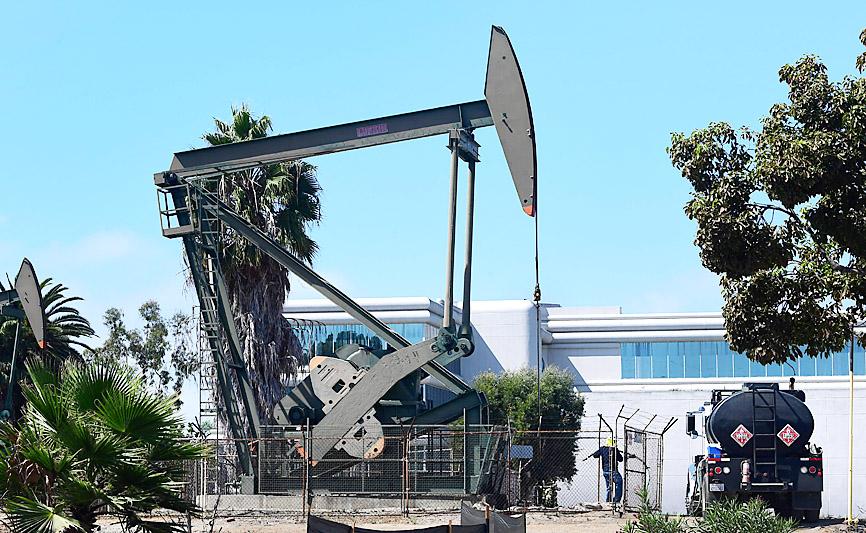Oil fell this week with spreading COVID-19 cases in countries such as India tempering optimism around positive signs out of the US and Europe.
West Texas Intermediate for May delivery rose US$0.71 to US$62.14 a barrel, but posted a decline of 1.57 percent for the week as the market weighed a global economic reopening that is coming in fits and starts.
Brent crude for May delivery also increased US$0.71 to US$66.11 a barrel, dropping 0.99 percent from a week earlier.

Photo: AFP
The US has remained near the forefront of the world’s budding demand recovery from the COVID-19 pandemic, and the latest manufacturing figures out of Europe have stoked optimism around a recovery there.
However, India has been setting record numbers of daily COVID-19 cases, threatening demand in the world’s third-largest oil importer.
Its diesel and gasoline consumption could fall by one-fifth this month, and traders said the nation’s largest refiner had refrained from buying West African oil this week, defying expectations.
“There was a real strong belief that we were going to see a very robust demand outlook from Asia,” Oanda Corp senior market analyst Edward Moya said.
However, with concerns in countries such as India and Japan, Moya said it shows “the global economic recovery is not going to be balanced by any means, and that’s going to derail the international travel situation.”
Oil is up almost 30 percent this year, but prices have struggled to reach new heights recently with the COVID-19 situation deteriorating in some key oil consuming countries.
India’s combined consumption of diesel and gasoline is poised to plunge by as much as 20 percent this month from a month earlier due to renewed restrictions, officials from refiners and fuel retailers have said.
Meanwhile, Japan is facing an increase in cases and a state of emergency has been declared from today to May 11 in prefectures including Tokyo.
“In the short-term, the market is facing an uneven recovery in demand,” Commodity Research Group senior partner Andrew Lebow said. “With concerns around India and Japan, which are two of the top five consumers of petroleum products, the market is trying to gauge where we’re going on demand.”
While India has so far avoided re-entering a nationwide lockdown, the demand impact would be comparable to the one faced during last year’s initial wave were it to do so, Cornerstone Macro analysts Jan Stuart and Thomas Marchetti said in a note.
Still, prices have averted further losses, aided by the rollout of COVID-19 vaccines and vigilant supply management from OPEC and its allies.
OPEC+ is set to start easing deep supply curbs from May, and the group is expected to hold a full ministerial meeting next week to assess the global state of play.

ADVANCED: Previously, Taiwanese chip companies were restricted from building overseas fabs with technology less than two generations behind domestic factories Taiwan Semiconductor Manufacturing Co (TSMC, 台積電), a major chip supplier to Nvidia Corp, would no longer be restricted from investing in next-generation 2-nanometer chip production in the US, the Ministry of Economic Affairs said yesterday. However, the ministry added that the world’s biggest contract chipmaker would not be making any reckless decisions, given the weight of its up to US$30 billion investment. To safeguard Taiwan’s chip technology advantages, the government has barred local chipmakers from making chips using more advanced technologies at their overseas factories, in China particularly. Chipmakers were previously only allowed to produce chips using less advanced technologies, specifically

The New Taiwan dollar is on the verge of overtaking the yuan as Asia’s best carry-trade target given its lower risk of interest-rate and currency volatility. A strategy of borrowing the New Taiwan dollar to invest in higher-yielding alternatives has generated the second-highest return over the past month among Asian currencies behind the yuan, based on the Sharpe ratio that measures risk-adjusted relative returns. The New Taiwan dollar may soon replace its Chinese peer as the region’s favored carry trade tool, analysts say, citing Beijing’s efforts to support the yuan that can create wild swings in borrowing costs. In contrast,

TARIFF SURGE: The strong performance could be attributed to the growing artificial intelligence device market and mass orders ahead of potential US tariffs, analysts said The combined revenue of companies listed on the Taiwan Stock Exchange and the Taipei Exchange for the whole of last year totaled NT$44.66 trillion (US$1.35 trillion), up 12.8 percent year-on-year and hit a record high, data compiled by investment consulting firm CMoney showed on Saturday. The result came after listed firms reported a 23.92 percent annual increase in combined revenue for last month at NT$4.1 trillion, the second-highest for the month of December on record, and posted a 15.63 percent rise in combined revenue for the December quarter at NT$12.25 billion, the highest quarterly figure ever, the data showed. Analysts attributed the

Taiwan Semiconductor Manufacturing Co’s (TSMC, 台積電) quarterly sales topped estimates, reinforcing investor hopes that the torrid pace of artificial intelligence (AI) hardware spending would extend into this year. The go-to chipmaker for Nvidia Corp and Apple Inc reported a 39 percent rise in December-quarter revenue to NT$868.5 billion (US$26.35 billion), based on calculations from monthly disclosures. That compared with an average estimate of NT$854.7 billion. The strong showing from Taiwan’s largest company bolsters expectations that big tech companies from Alphabet Inc to Microsoft Corp would continue to build and upgrade datacenters at a rapid clip to propel AI development. Growth accelerated for